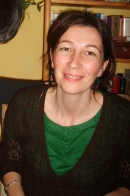 E-mail address: fuziza@yahoo.com
E-mail address: fuziza@yahoo.com
Home institution: University of Szeged,
Department of Visual Culture and Literary Theory
Academic position: associate professor
Areas of research: narrative theory, early film theory,
mediality, Hungarian film theory
Title of the presentation: Movement, Temporality, and
Medium Specificity in Early Hungarian Film Theory
Most important Publications
Books:
- Verbális és vizuális narráció [Verbal and Visual Narration] Apertúra Books. Szeged, Pompeji (ed. and introductions) (date of publication: October 2011)
- Hitchcock: kritikai olvasatok. [Critical Readings of Hitchcock] Apertúra Books. Szeged, Pompeji (ed. and introduction) (date of publication: February 2010)
- Marc Vernet: A hiány alakzatai. A láthatatlan és a mozi. [Figures of absence] Apertúra Books. Szeged, Pompeji (co-transl., ed. and introduction) (date of publication: March 2010)
- Retorika, nyelv, elmélet. [Rhetoric, Language and Theory] Szeged, JATE Press, 2009
- Bevezetés az epikai szövegek és a narratív film elemzésébe. [Introduction to the analysis of epic fiction and narrative film] Szeged, 2006 ? co-author: Török Ervin
- Retorikai füzetek II. Paul de Man ?retorikája? [Rhetorical Series II. The ?Rhetoric? of Paul de Man] (editing) Gondolat-Pompeji, Budapest, 2004
- Retorikai füzetek I. Figurák [Rhetorical Series. I. Figures] (ed. and introduction) Gondolat-Pompeji, Budapest, 2004
Essays:
- Image and event in recent Hungarian film, in Orientation in Occurrence, ed. by Berszán István. Cluj-Napoca, 2009. 331-341.
- ?Double Projection?. Tendencies in Hungarian Film Theory. European Network for Cinema and Media Studies. Budapest Conference Papers
- The Face of the Landscape in Balázs. Acta Univ. Sapientiae, Film and Media Studies (forthcoming)
- A hang funkciói Balázs filmesztétikájában a hangos váltás kontextusában [Functions of sound in Balázs?s film aesthetics in the context of the transition to sound]. Apertúra (Fall 2011)
- Arc, hang, tekintet: szemiotikai, esztétikai és politikai összefüggések Balázs Béla filmesztétikájában [Face, sound, gaze: semiotic, aesthetic and political relations of Béla Balázs' film aesthetics]. Apertúra (Fall 2009)
- Where is Reality? Gábor Bódy?s Film Theory. Acta Univ. Sapientiae, Film and Media Studies, 1 (2009), 35-46.
Title of the presentation
Movement, Temporality, and Medium Specificity in Early Hungarian Film Theory
Abstract
The primary concern of early film theoreticians or aestheticians was to establish the medium specific features of cinema which would grant the status of art to this new medium. Assigning a place for cinema was a challenging task considering the altogether new experiences viewers of the first moving pictures were confronted with. In my paper I will show how these highly general speculations on the aesthetic value of cinema foster not only new conceptualizations of the moving image to the present day, but they offer new ways to rethink the place and function of the other arts, too. Aesthetic writings from 1920s seek an idealized form of cinema; rarely giving actual examples from the cinema of their era, they emphasize the potentialities lying within this new possibility. They envision cinema as the new site of the imaginable, conceivable, something which is waiting for us, but perhaps can never be achieved.
Early Hungarian film theorists concentrate on a few recurrent and interconnected groups of questions: 1. How will the technique of cinema affect perception and human consciousness? 2. How it relates to the concept of time? (According to Karinthy [1909] cinema will abolish the past by generating an eternal and uncanny present.); 3. What are the possibilities of cinema to become an art form and what is the place it occupies in the matrix of the different branches of art? The later question is often discussed in terms of materiality of cinema, or the specific features which give cinema a special place within other art forms. The most well-known formulation is Balázs?s who propagates cinema as the corner stone of the new visual culture. While legibility based on printed word made the expressive potentialities of the body unnecessary, the token of the new visibility is the body and its movements, opposed to the conceptual culture which ?buried [human beings] under mountains of words and concepts? (Balázs 2009, 11).
Miklós Marsovszky (1927) ? from an approach we could call bergsonian ? explains how all forms of art are troubled by the idea of movement, because their form is confined to bordering and ceasing movement. Drama concentrates movement into action composed of words and the actors? body. Epic widens the circle of movement by giving a form to the flow of life, but this can be achieved through the halting of movement into situations. Movement in narrative is expressed only in term of goals and cause-effect relations. Pantomime forces the body into allegorical movements and can be dismissed just like dance which uses movement as a filling out of space. The movement to which cinema gives form should be liberated from any intellectual conceptualization, a living and immediate continuity which is endangered even by visuality, the tableau-character of the image. What are the possibilities of cinema to relate to this kind of movement and temporality?
In my paper I will deal with the different conceptualization of the moving image which endeavour to account for the power of cinema by repositioning the art forms along new aesthetic categories.
